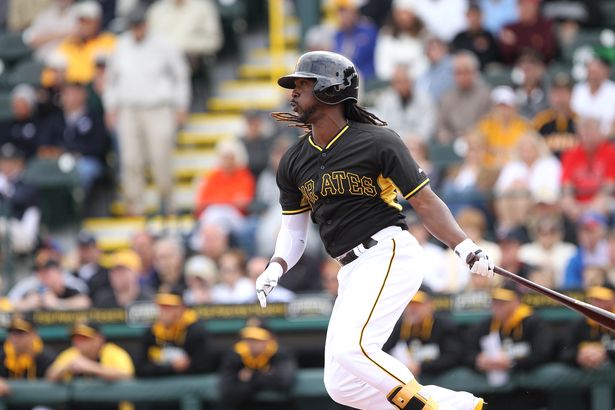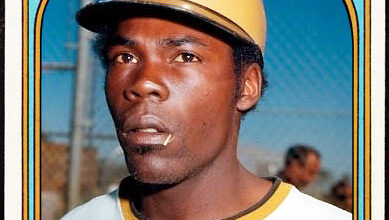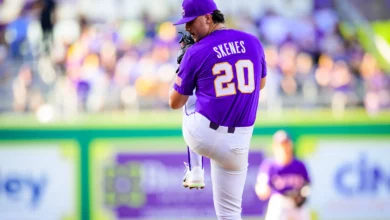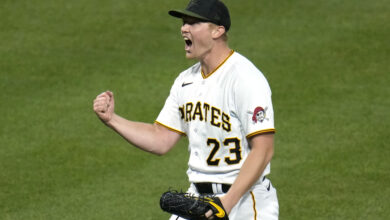
In recent days, the Pittsburgh Pirates have:
- Signed free agent first baseman Rowdy Tellez to a one-year contract;
- Traded for pitcher Marco Gonzales and outfielders Edward Olivares and Billy McKinney;
- Announced catcher Endy Rodriguez and pitcher Johan Oviedo will miss the 2024 season;
- Signed free agent pitcher Martin Perez to a one-year, $8 million deal; and
- Brought back Andrew McCutchen for at least one more year.
Their rivals in the National League Central Division aren’t exactly standing still either. Are the Pirates doing enough?
Enter Gonzales
On December 5, the Pirates acquired Gonzales, 31, from the Atlanta Braves for the proverbial cash-or-a-player-to-be-named-later, two days after the Braves acquired him in a five-player deal with the Seattle Mariners. In an injury-shortened 2023, the soft-tossing lefty starter was 4-1 with a 5.22 ERA and 1.460 WHIP in 10 games. Over his nine major-league seasons, he’s 65-49, posting a 4.14 ERA and 1.289 WHIP.
Why this might work: Gonzales is the type of left-handed starter with whom pitching coach Oscar Marin has had success. Tyler Anderson and Jose Quintana revived their careers under one-year deals with the Pirates. They would parlay their success in Pittsburgh into lucrative contracts elsewhere. Pitching in a home ballpark that features a deep left field that favors left-handed pitchers, Gonzales will hope to pitch well enough for the Pirates to trigger his 2025 $15 million option or earn a similar pay on the free agent market. This could be a nice low-risk play for the Pirates. The Braves and Mariners are responsible for most of his $12.5 million salary in 2024. Besides, the Pirates enter 2024 with only one reliable starter in Mitch Keller. They need some warm bodies on the mound. They can’t keep getting away with as many bullpen games as they had in 2023.
Why this might not work: Despite respectable career stats, most of Gonzales’s good work happened before 2021. In 2022, Gonzales led the American League in losses when he was 10-15. His 4.13 ERA for 2022 was not far off his career number. However, he had an unsightly 5.05 FIP to go with it. In 2021, he was better at 10-6 with a 3.96 ERA. But his 5.28 FIP suggests luck played a big role in whatever positive results he achieved. It’s often said lefties develop late, but he’s going in the opposite direction. We’ll see whether Marin can work his magic and put Gonzales in the right direction.
Getting Rowdy
A player whom general manager Ben Cherington would have known from his time in Toronto, the left-handed power-hitting Tellez hit .215/.291/.376, 13 HR and 47 RBIs in an injury-plagued 2023 for the Milwaukee Brewers. That earned him a $3.2 million deal, a relative pittance in today’s baseball, with incentives that could yield him a total haul of $4 million for 2024. Over this six-year career, Tellez, 28, has hit .233/.304/.446 with 92 HR and 263 RBIs. The acquisition was a bit of a head-scratcher, as Tellez doesn’t feature the on-base skills the Pirates covet.
Why this might work: Tellez is only a year removed from a strong 2022 when he hit 35 homers despite a .219/.306/.461 slash line. Aiming for PNC Park’s short right field, he seems a better bet to produce homers at a rate more in line with 2022 than 2023. His career 45.1 per cent hard-hit rate is well above the major-league average of 39 per cent over the same time, suggesting there might be more offensive potential there than he’s shown so far.
Why this might not work: The Pirates had a big hole to fill at first base. At six-foot-four, 270 pounds, Tellez can fill a hole of just about any width. With that size, Tellez is a legitimate power hitter — but that’s all he is. As noted, he doesn’t get on base much. He also doesn’t contribute much in the field or on the bases. He’s “worth” a negative 13 Defensive Runs Saved over his career. Meanwhile, his base-running stats show a player whose run-scoring and extra-base-taking are well below major-league averages. He won’t be much help unless he regains that 35-homer stroke in 2024.
The same old song?
With Cherington having stated the Pirates are looking to contend in 2024 and would be doing things differently as far as spending and the type of player they would look to acquire, the additions of Gonzales and Tellez were greeted with a collective yawn by Pirates fans, who saw them as more of the same old, same old, a couple of reclamation projects who, if they turn their careers around, would be flipped for prospects at the trade deadline. In my opinion, it didn’t seem Cherington had done enough up to that point. But I also realized there’s plenty of time yet and there were apparently more dollars to be spent. As a Pirates fan, I could be happy with Tellez at first base and Gonzales at the back of the rotation if another front-line starter or two were brought in. We needed to wait until the other shoe dropped.
The other shoe drops
The other shoe dropped in the form of Perez, 32, from the world champion Texas Rangers. Another left-handed starter who doesn’t blow up the radar gun, over 12 years he is 85-81 with a 4.44 ERA and 1.442 WHIP. In 2023, he was 10-4 with a 4.45 ERA and 1.405 WHIP over 35 games, which included 20 starts. Perez was banished to the bullpen when the Rangers picked up Max Scherzer and Jordan Montgomery at the trade deadline.
Why this might work: See Gonzales, above, where I note Marin’s success with pitchers of this type and the advantages PNC Park affords a left-handed pitcher. Add the fact that Perez is one year removed from a stellar 2022 where he was 12-8 with a 2.89 ERA, named to the All-Star Game and earned a $19.65 million contact for 2023. He is familiar with Marin thanks to Marin’s time in the Rangers’ organization. Working with Marin might help him rediscover what worked in 2022.
Why this might not work: It’s clear 2022 was an anomaly, to use a Supreme Court word. For his next-best year, one must go all the back to 2012, when he was 10-6 with a 3.62 ERA in 20 starts and received votes for Rookie of the Year. Chances are the Pirates aren’t getting the Perez of 2022.
Even so, of the three major additions discussed here, Perez seems least likely to disappoint, as long as expectations are kept reasonable. He’s the proverbial guy who “takes the ball,” having pitched in at least 32 games in six of the last seven non-COVID years. If he can take his regular turn and keep the team in the game before turning it over to Pittsburgh’s solid late-inning bullpen, he just might help.
Leyland in the Hall of Fame
Now if you’ll permit me a few personal opinions and recollections, let’s leave the 2024 Pirates. By now you know former Pirates manager Jim Leyland was elected to the Baseball Hall of Fame by the Contemporary Baseball Era Committee on December 3. He arrived in Pittsburgh in 1986 a no-name, but would turn around a dismal team and lead them to three division championships over 1990-1992, never getting past the National League Championship Series. He won a World Series with the Florida Marlins in 1997 and led the Detroit Tigers to two American League pennants. Leyland would also leave the Pirates in 1996 and the Marlins in 1998 when the teams announced plans to reduce payroll.
I would be a tough voter and thus I don’t see Leyland as worthy of the Hall. The first two managers so inducted were John McGraw (10 pennants and three World Series championships in 33 years) and Connie Mack (nine pennants and five World Series titles in 53 years). For me, that’s the standard. Leyland falls short, as do many other managers already in the Hall.
“Congratulations, Coach!”
The media in Pittsburgh have clamored for Leyland’s induction for a long time. He’s a beloved figure in the local media — if not among Pirates fans who resent his leaving — and indeed, he’s a very nice man. A few short days after the painful loss to the Atlanta Braves in the 1992 championship series, my wife and I made what was then an annual trip to Reilly’s Summer Seat Farms north of the city so our kids could get pumpkins for Halloween. There was Leyland with his own little boy. I pointed him out to the family and said, “Let’s leave him alone. He’s with his boy and just lost a tough one.”
My then-four-year-old daughter, showing the obedience we came to expect of her as a toddler, immediately lit out for Leyland. She stopped in front of him, extended her hand and said, “Congratulations, Coach!” What she could have been congratulating him for is anybody’s guess. Leyland crouched down to her eye level and spoke with her for a good two minutes. Time it on your watch right now; it’s a long time. I kept my distance and couldn’t hear what was said. Maybe they were discussing the proper time to utilize the suicide squeeze. At any rate, he patted her on the head and she ran back to her family, happy. I’ve heard many similar stories from others who encountered Leyland. For that reason, I’m glad he’s going into the Hall.
RIP, Vic Davalillo
The news came on December 6 that Vic Davalillo had passed away at age 84. From 1963-1980, he was a speedy outfielder and heady player who hit and defended well. With the Indians, he won a Gold Glove Award in 1964 for his work in Cleveland’s cavernous center field and was selected for the All-Star Game the following year. However, by 1969 with the Angels, he was no longer a regular. The Pirates picked him up from the Cardinals in 1971. He was a key member of that World Series championship team, filling in all over the outfield and first base.
It is said Davalillo was known to enjoy more than a drink or two. “Crazy Vic” they called him, according to Dave Parker‘s book Cobra”>Dave Parker’s book Cobra. In his book A Pirate For Life, Steve Blass tells of getting ready to start a game in Chicago. Blass got to the team bus early. There he encountered Davalillo sleeping it off from the night before. Suddenly, Davalillo spotted Colonel Sanders — yes, that Colonel Sanders — leaving the hotel, at which point Davalillo began shouting obscenities and making obscene gestures toward the famed purveyor of buckets of fast-food chicken, extra crispy if you want it. The story of the drunken ballplayer and the good colonel going at it is worth the price of the book.
“He’s gonna blow it.”
However, my favorite Davalillo memory occurred during the pivotal third game of the 1977 National League Championship Series between the Dodgers and Phillies. Davalillo was back in the United States as a Dodger after a few years playing professionally in Mexico. At home in Veterans Stadium, the Phillies held a 5-3 lead with two outs and nobody on base in the Dodgers’ half of the ninth inning. Gene Garber was pitching for Philadelphia.
I was away at college, watching the game in my dorm room with, inter alios, Frank Brown, a friend from New Jersey who was a staunch fan of all Philadelphia teams. He had an intense dislike of Garber. Frank kept repeating, “He’s gonna blow it. He’s gonna blow it,” even when Garber needed just one more out and was facing a 37-year-old pinch hitter in Davalillo. Sure enough, Davalillo wisely took advantage of the infielders’ positions and bunted toward the second baseman for a base hit.
The next batter, another pinch hitter in Manny Mota, then 39, launched a deep drive to left field over the head of Greg Luzinski, who was to outfield defense what Tellez is to first base defense. Davalillo scored. Singles by the next two batters gave the Dodgers a 6-5 win. It was one of those games where the losing team had to have been so shell-shocked, one already knew they would lose the next day, too. I can’t think about Davalillo without seeing Frank shaking his head, saying, “He’s gonna blow it” over and over again, until Garber did indeed “blow it.”




